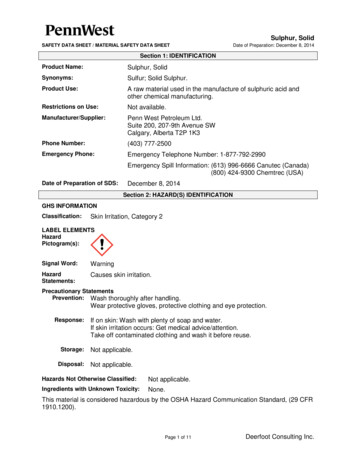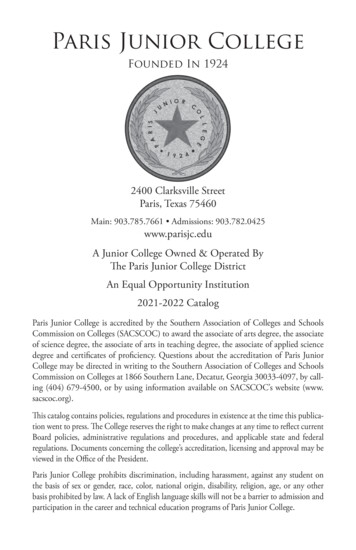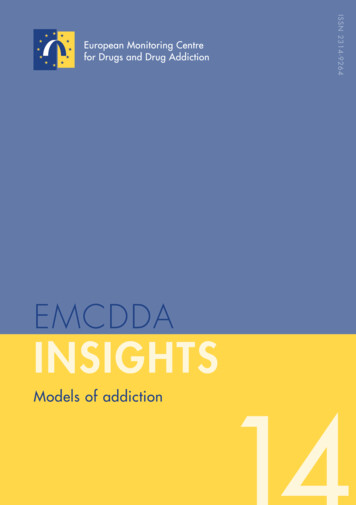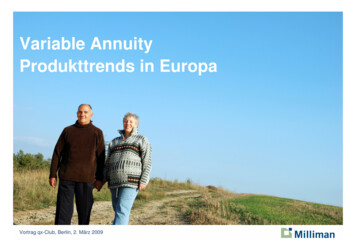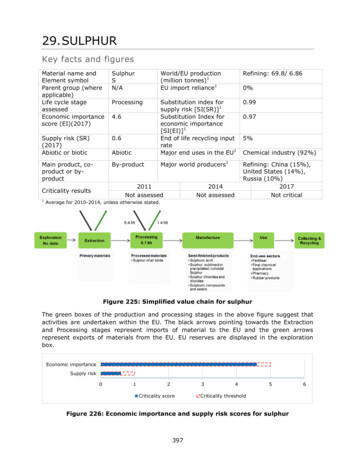
Transcription
29. SULPHURKey facts and figuresMaterial name andElement symbolParent group (whereapplicable)Life cycle stageassessedEconomic importancescore (EI)(2017)SulphurSN/AWorld/EU production(million tonnes)1EU import reliance1Refining: 69.8/ 6.86Processing0.99Supply risk (SR)(2017)Abiotic or biotic0.6AbioticSubstitution index forsupply risk [SI(SR)]1Substitution Index foreconomic importance[SI(EI)]1End of life recycling inputrateMajor end uses in the EU1Main product, coproduct or byproductBy-productMajor world producers1Refining: China (15%),United States (14%),Russia (10%)2017Not critical2011Not assessedCriticality results14.60%2014Not assessed0.975%Chemical industry (92%)Average for 2010-2014, unless otherwise stated.Figure 225: Simplified value chain for sulphurThe green boxes of the production and processing stages in the above figure suggest thatactivities are undertaken within the EU. The black arrows pointing towards the Extractionand Processing stages represent imports of material to the EU and the green arrowsrepresent exports of materials from the EU. EU reserves are displayed in the explorationbox.Economic importanceSupply risk0123Criticality score45Criticality thresholdFigure 226: Economic importance and supply risk scores for sulphur3976
29.1 IntroductionSulphur is a chemical element with symbol S and atomic number 16.Sulphur is a multivalent non-metal, abundant, tasteless and odourless. In its native formsulphur is a yellow crystalline solid. In nature it occurs as the pure element or as sulphideand sulphate minerals. Although sulphur is infamous for its smell, frequently compare torotten eggs, that odour is actually characteristic of hydrogen sulphide (H 2S). Thecrystallography of sulphur is complex. Depending on the specific conditions, sulphurallotropes form several distinct crystal structures (Lenntech, 2016).The major derivative of sulphur is sulphuric acid (H 2SO4), one of the most importantmaterials used in the base industries (Lenntech, 2016). Sulphur can therefore beconsidered one of the most important industrial elements in terms of volume.Sulphur is one of the so-called materials for life, next to hydrogen, carbon, phosphorous,oxygen and nitrogen.29.2 Supply29.2.1 Supply from primary materials29.2.1.1 Geological occurrence/explorationThe presence of sulphur in the earth’s crust is quite common, with 621 parts per millionupper crustal abundance (Rudnick & Gao, 2003).Sulphur is mostly associated with volcanic activity. Most of the native sulphur occursnaturally as massive deposits. Many sulphide minerals are known: pyrite and marcasite areiron sulphide; stibnite is antimony sulphide; galena is lead sulphide; cinnabar is mercurysulphide and sphalerite is zinc sulphide. Other, more important, sulphide ores arechalcopyrite, bornite, pentlandite, milarite and molybdenite (Lenntech, 2016).29.2.1.2 ProcessingSulphur is a by-product in most cases, and a co-product in virtually the other cases. It isestimated that recovered elemental sulphur or by-product sulphuric acid, increasing thepercentage of by-product sulphur production to about 90% annually (USGS, 2016a).Sulphur production is for 50% of the annually produced volumes a result of processing offossil fuels, especially natural gas. This had an severe effect on discretionary miningoperations, i.e. operation with the goal to extract ores that would enable voluntarilyproduction of sulphur. The large fossil fuel and metal processing industries in the world canbe described as non-discretionary: sulphur is obtained as involuntary by-product.Discretionary mined ores are beneficiated using the conventional mining method for pyritesor the Frasch process.Conventional mining methods for pyrites refer to sulphide containing ores. Sulphur emergesas by-product of several metal refining processes. For instance, nickel concentrations ofsulphide ores are the most important source of nickel. Sulphide containing ores are alsorelevant for lead, silver, tin and copper. By far the largest use of manganese (more than90%) in steel production is as reduction and desulphurization agent (European Commission,2014), indicating the separation of sulphur as well. This means that sulphur, next to the50% coming from fossil fuel processing, is also obtained in various forms is obtained inmetallurgical processes (close to 40% of the world’s supply).398
In the Frasch process, native sulphur is melted underground with superheated water andbrought to the surface by compressed air. As of 2011, the only operating “Frasch” minesworldwide are in Poland and since 2010 in Mexico. The last mine operating in the UnitedStates closed in 2000. (Sulphur institute, 2016).29.2.1.3 Resources and reservesThere is no single source of comprehensive evaluations for resources and reserves thatapply the same criteria to deposits of sulphur in different geographic areas of the EU orglobally. The USGS collects information about the quantity and quality of mineral resourcesbut does not directly measure reserves, and companies or governments do not directlyreport reserves to the USGS. Individual companies may publish regular mineral resourceand reserve reports, but reporting is done using a variety of systems of reporting dependingon the location of their operation, their corporate identity and stock market requirements.Translations between national reporting codes are possible by application of the CRIRSCOtemplate 27 , which is also consistent with the United Nations Framework Classification(UNFC) system. However, reserve and resource data are changing continuously asexploration and mining proceed and are thus influenced by market conditions and should befollowed continuously.For Europe, there is no complete and harmonised dataset that presents total EU resourceand reserve estimates for sulphur. The Minerals4EU project is the only EU-level repositoryof some mineral resource and reserve data for sulphur, but this information does notprovide a complete picture for Europe. It includes estimates based on a variety of reportingcodes used by different countries, and different types of non-comparable datasets (e.g.historic estimates, inferred reserves figures only, etc.). In addition, translations ofMinerals4EU data by application of the CRIRSCO template is not always possible, meaningthat not all resource and reserve data for sulphur at the national/regional level is consistentwith the United Nations Framework Classification (UNFC) system (Minerals4EU, 2015).Manydocumented resources in Europe are based on historic estimates and are of little currenteconomic interest. Data for these may not always be presentable in accordance with theUNFC system. However a very solid estimation can be done by experts.Given the abundance of Sulphur in several material flows, the reserves of sulphur andsulphide ores are large (USGS, 2016a).29.2.1.4 World productionThe global production of sulphur between 2010 and 2014 was annually 69.8Mt on average.Figure 227 illustrates the widely dispersed industrial activities that lead to the production ofsulphur. More than half of the world production takes place in “other” countries, mostlyfollowing involuntarily production of sulphur from in the metal and fossil fuel industries.27www.crirsco.com399
China15%United States14%Othercountries52%Russia10%Canada9%Total production : 69.8 MtFigure 227: Global production of sulphur, average 2010–2014 (Data from BMWFW,2016)29.2.2 Supply from secondary materialsThe end-of-life recycling input rate for sulphur is estimated to be 5%. This refers to spentsulphuric acid, which is reclaimed from petroleum refining and chemical processes duringany given year (USGS, 2016a).However, this number requires some further interpretation. The voluntary extraction ofsulphur containing ores is made less relevant by the large volumes of sulphur that becomeavailable as by-product. The recycling input rate from that perspective is much larger.29.2.3 EU tradeThe volumes of internationally traded sulphur are small compared to the annual production.The volumes of traded sulphur are relatively constant, as shown in Figure 228. The EU is anet exporter of sulphur.2,000,0001,500,000Trade flows (t)1,000,000500,000EU imports (t)020102011201220132014EU exports (t)Net imports (t)-500,000-1,000,000-1,500,000-2,000,000Figure 228: EU trade flows for sulphur (Data from Eurostat Comext 2016)400
The trade of sulphur is associated with flows of material related to countries importingnatural gas to the EU. The total volume of EU imports was 425Kt on average, a smallfraction of the EU consumption. The majority of EU-28 imports originates from Kazakhstan(52%), followed by Russia (34%).Switzerland1%Bosnia ey3%Norway3%Kazakhstan52%Russia34%Total import : 425.8 thousand tonnesFigure 229: EU imports of sulphur, average 2010-2014 (Data from EurostatComext, 2016)EU trade is analysed using product group codes. It is possible that materials are part ofproduct groups also containing other materials and/or being subject to re-export, the"Rotterdam-effect". This effect means that materials can originate from a country that ismerely trading instead of producing the particular material.No trade restrictions were reported over the 2010-2014 period (OECD, 2016). Some EUfree trade agreements are in place with suppliers such as Turkey, Norway, Serbia, Bosniaand Switzerland (European Commission, 2016).29.2.4 EU supply chainThe EU relies for the supply of sulphur for 0% on its imports. Given the sizeablepetrochemical and metallurgical industries in the EU, there is an abundance of sulphur inEuropean manufacturing processes.There is no trade restriction associated with the product groups that contain highconcentrations of sulphur (OECD, 2016).Figure 230 shows the EU sourcing (domestic production imports) for sulphur.401
United States2%Sweden3%Other non EUcountriesOther EUBolivia Mexico17%Total EU sourcing: 12,000 tonnesFigure 230: EU sourcing (domestic production imports) of sulphur, average2010-2014 (Eurostat, 2016; USGS, 2016a)29.3 Demand29.3.1 EU consumptionThe EU consumption of sulphur was on average 7.2 Mt between 2010 and 2014. Asmentioned in the trade section, the sizeable EU industries mostly provide the volumesrather than importing industries.29.3.2 Applications / End usesMost sulphur is used in the shape of acids. Sulphuric acid is an essential intermediate inmany processes in the chemical and manufacturing industries. Sulphuric acid also is usedby the fertilizer industry to manufacture primarily phosphates, nitrogen, potassium, andsulphate fertilizers. It is also used in manufacturing other products, including non-ferrousmetals, pigments, fibres, hydrofluoric acid, carbon disulphide, pharmaceuticals, agriculturalpesticides, personal care products, cosmetics, synthetic rubber vulcanization, watertreatment, and steel pickling (Sulphur institute 2016).Sulphuric acids ire also used in detergents, fungicides, manufacture of fertilizers, gun power,matches and fireworks. Other applications are making corrosion-resistant concrete whichhas great strength and is frost resistant, for solvents and in a host of other products of thechemical and pharmaceutical industries (Lenntech, 2016).The dominance of applications forthe chemical industry for sulphur is illustrated in Figure 231.The reason sulphur is chiefly allocated to chemical applications as NACE2 digit sector is thatthe applications metal products manufacturing normally take place on the production sitewithout the materials entering the supply chain (Vandenbroucke, 2016).402
otal consumption : 7.29 MtFigure 231: Global/EU end uses of sulphur, average 2010-2014 (Data fromSulphur institute 2016)The calculation of economic importance is based on the use of the NACE 2-digit codes andthe value added at factor cost for the identified sectors (Table 141). The value added datacorrespond to 2013 figures.Table 141: Sulphur applications, 2-digit NACE sectors associated 4-digit NACEsectors and value added per sector (Data from the Eurostat database, Eurostat,2016)Applications2-digit NACE sector4-digit NACE sandchemicalproductsC21 - Manufacture of ationsC22 - Manufacture of rubberand plastic productsC20.13 - Manufacture ofotherinorganicbasicchemicalsC21.10 - Manufacture sC22.19 - Manufacture ofother rubber productsValue addedof sector(millions )110,00079,54582,00029.3.3 PricesGiven the global availability of sulphur, we can consider price developments in the UnitedStates to illustrate the development of the commodity cost in recent decades. The priceshows a remarkable volatility since 1945, with highly unusual spikes between 2005 and2012. The demand shifts for sulphuric acid and the creation of large stocks and inventoriesare the cause of this volatility, which has reduced in 2013 and 2014.403
Figure 232: Global developments in price of sulphur, average 1945-2014 (USGSb,2016)29.4 SubstitutionThere are no known substitutes for sulphur as “materials for life”, being essential foragriculture.The use of sulphuric acids can be substituted by various acids, although the total size of thissubstitution is set at 15% in the criticality assessment. The applications of sulphuric acids inindustrial processes are numerous and it is difficult to ascertain to what extent these can beinstantly changed by substituting H2SO4 (Vandenbroucke, 2016).In reverse, sulphur can provide opportunities to substitute other materials. Sulphur dioxidecan be used as a replacement for selenium dioxide in the production of electrolyticmanganese metal. Silicon and sulphur are major substitutes for selenium in low, mediumand high voltage rectifiers, and solar photovoltaic cells (European Commission, 2014).29.5 Discussion of the criticality assessment29.5.1 Data sourcesThe CN codes used for the criticality assessment are 2503 0010 and 2503 0090. They arerespectively labelled “Sulphur of all kinds (excl. crude or unrefined, and sublimed sulphur,precipitated sulphur and colloidal sulphur)” and “Sulphur, sublimed or precipitated; colloidalSulphur”. The fact that elemental sulphur is present in several other product groups (acids,fuels, liquids, minerals) is discarded since it is unclear when elemental sulphur, if at all, willbe separated in the supply chain.The data sources have a very strong coverage. Data is available on EU level, is available fortime series and updated at regular intervals and is publicly available.29.5.2 Calculation of Economic Importance and Supply Risk indicatorsSulphur clearly needs to be assessed at the processing stage, given the dominant role ofsulphur as a by-product.404
The economic importance of sulphur originates from the dominance of its applications in thechemical industry. The supply risk is relatively modest given the many suppliers andsubstation options.The supply risk was assessed for sulphur using both the global HHI and the EU-28 HHI asprescribed in the revised methodology.29.5.3 Comparison with previous EU assessmentsSulphur is being assessed for the first time in 2017 with the EI and SR results presented inthe following table. Sulphur was not assessed in 2011 or in 2014, therefore, it is notpossible to make any comparisons with the previous assessments.Table 142: Economic importance and supply risk results for sulphur in theassessments of 2011, 2014 (European Commission, 2011; European Commission,2014) and 2017Assessment20112014IndicatorEISRSulphurNot assessedEI2017SRNot assessedEISR4.60.629.6 Other considerations29.6.1 Forward look for supply and demandDemand of sulphur will be dominated by developments in other agriculture and base metal(TSI, 2012).Uncertainty in the global fossil fuel production may affect the supply. The supply of sulphurcan be adjusted i.e. increased by changing volumes from other processes, but it remains tobe seen how the market response will be to such a change. See Table 143.Table 143: Qualitative forecast of supply and demand of of sulphurMaterialsCriticality ofthe materialYesSulphurDemand forecastSupply forecastNo5 years10 years20 years5 years10 years20 yearsx /0 /029.6.2 Environmental and regulatory issuesSulphur is present in many economically relevant flows in the soil, water and air. This isillustrated by the fact that elemental sulphur (and by-product sulphuric acid), produced as aresult of efforts to meet environmental requirement, contribute to world supply (USGS,2016a). Atmospheric sulphur oxides, SO 2 in particular, are emission that need to bereduced to increase health standards in parts of the EU (EEA, 2016). The level of sulphur inseveral environments is thus closely regulated. This requires the use of other raw materialsto purify water and soils. For instance, a growing amount of limestone is used to removesulphur dioxide from flue gases, for sewage treatment and for drinking water treatment(European commission, 2014).Besides surplus, instances of dearth of Sulphur in the environment are also reported. Theincidence of soil sulphur deficiency has rapidly increased in recent years. Three majorfactors are responsible for increased sulphur deficiency: a) intensified cropping systemsworldwide demand higher sulphur nutrient availability; b) increased use of high-analysis,405
sulphur-free fertilizers, and c) reduction of sulphur dioxide emissions, particularly indeveloped regions, reduces atmospheric sulphur deposition, a "natural" sulphur source(Sulphur institute, 2016).29.7 Data sources29.7.1 Data sources used in the factsheetBGS (2016). World Mineral Production 2010-2014 [online]. Keyworth, Nottingham BritishGeological Survey, Available at: mlBMWFW (2016). World Mining Data. Sulfur. Pp. D2016.pdfofthePDFfile.European Commission (2011). Critical raw materials for the EU. [online] Available ls/specific-interest/critical enEuropean Commission (2014) Report on critical raw materials for the EU – Non Critical rawmaterials profiles.European Commission (2016). DG Trade. Agreements -and-regions/agreements/Availableat:Eurostat (2016)a. International Trade Easy Comext Database [online] Available tat (2016)b. Statistics on the production of manufactured goods (PRODCOM NACERev.2). [online] Available at: http://ec.europa.eu/eurostat/data/databaseEurostat (2016)c. Annual detailed enterprise statistics for industry (NACE Rev. 2, tat/en/web/products-datasets//SBS NA IND R2USGS (2016a). Apodaca, L.E. 2014 Minerals yearbook USGS. ommodity/sulfur/myb1-2014-sulfu.pdfat:29.7.2 Data sources used in the criticality s-1/assessment-3at:European Commission (2014). Report on critical raw materials for the EU. Available ls/specific-interest/critical enEurostat (2016). Annual detailed enterprise statistics for industry (NACE Rev. 2, tat/en/web/products-datasets//SBS NA IND R2Eurostat Comext (2016). International trade in goods database (COMEXT) Available ech (2016) Sulphur. [online] tp://minerals4eu.brgm-rec.fr/m4eu-yearbook/theme selection.html406Availableat:
OECD (2016). Export restrictions on Industrial Raw Materials database [online].http://qdd.oecd.org/table.aspx?Subject ExportRestrictions IndustrialRawMaterialsRudnick, R.L. and Gao. S. (2003). Composition of the Continental Crust. In: Treatise onGeochemistry, Volume 3. Editor: Roberta L. Rudnick. Executive Editors: Heinrich D. Hollandand Karl K. Turekian. pp. 659. ISBN 0-08-043751-6. Elsevier, p.1-64.Sulphur institute (2016). Learn more about files/DonMessick Sulphur Outlook.pdfAvailableAvailableat:at:USGS (2016b) Historical Statistics for Mineral and Material Commodities in the UnitedStates. [online] Available at: -statisticsVandenbroucke, J. (2016). Expert consultation.29.8 AcknowledgmentsThis Factsheet was prepared by the Netherlands Organisation for Applied Scientific Research(TNO). The authors would like to thank the EC Ad Hoc Working Group on Critical RawMaterials and all other relevant stakeholders for their contributions to the preparation ofthis Factsheet. Specific experts that have contributed their input and feedback to thefactsheet and criticality assessments are listed in the data sources section.407
Sulphur is one of the so-called materials for life, next to hydrogen, carbon, phosphorous, oxygen and nitrogen. 29.2 Supply 29.2.1. Supply from primary materials 29.2.1.1. Geological occurrence/exploration . The presence of sulphur in the earth's crust is quite common, with 621 parts per million upper crustal abundance (Rudnick & Gao, 2003).

